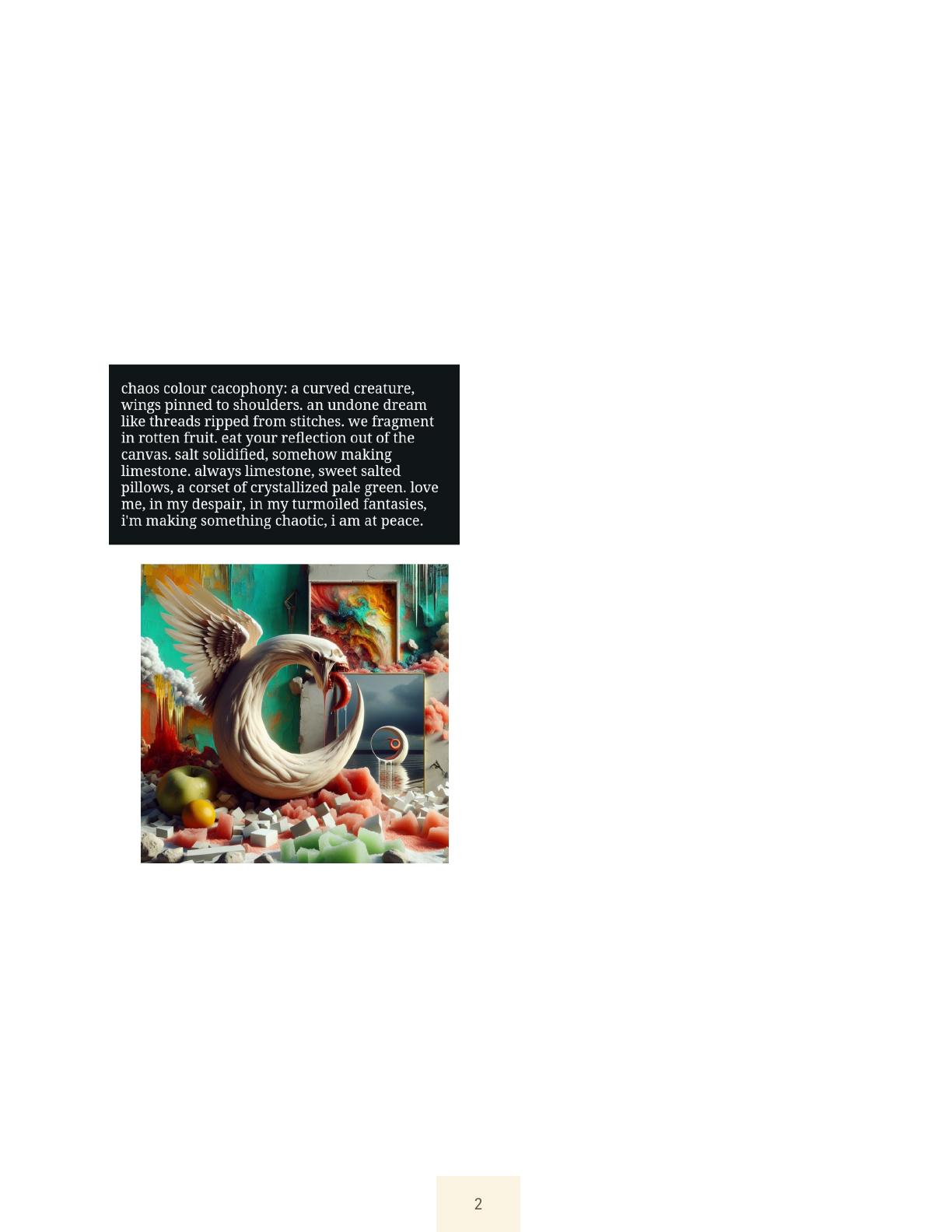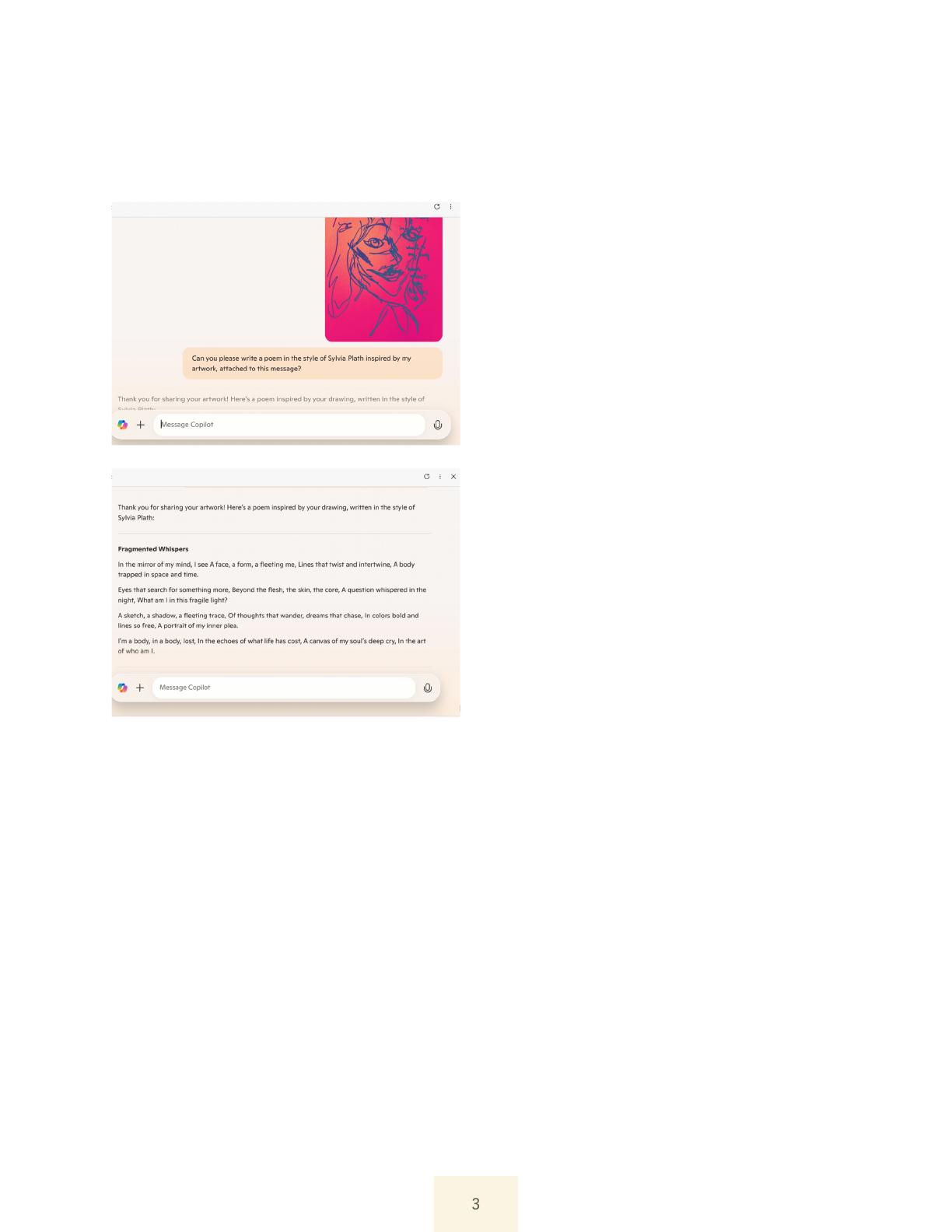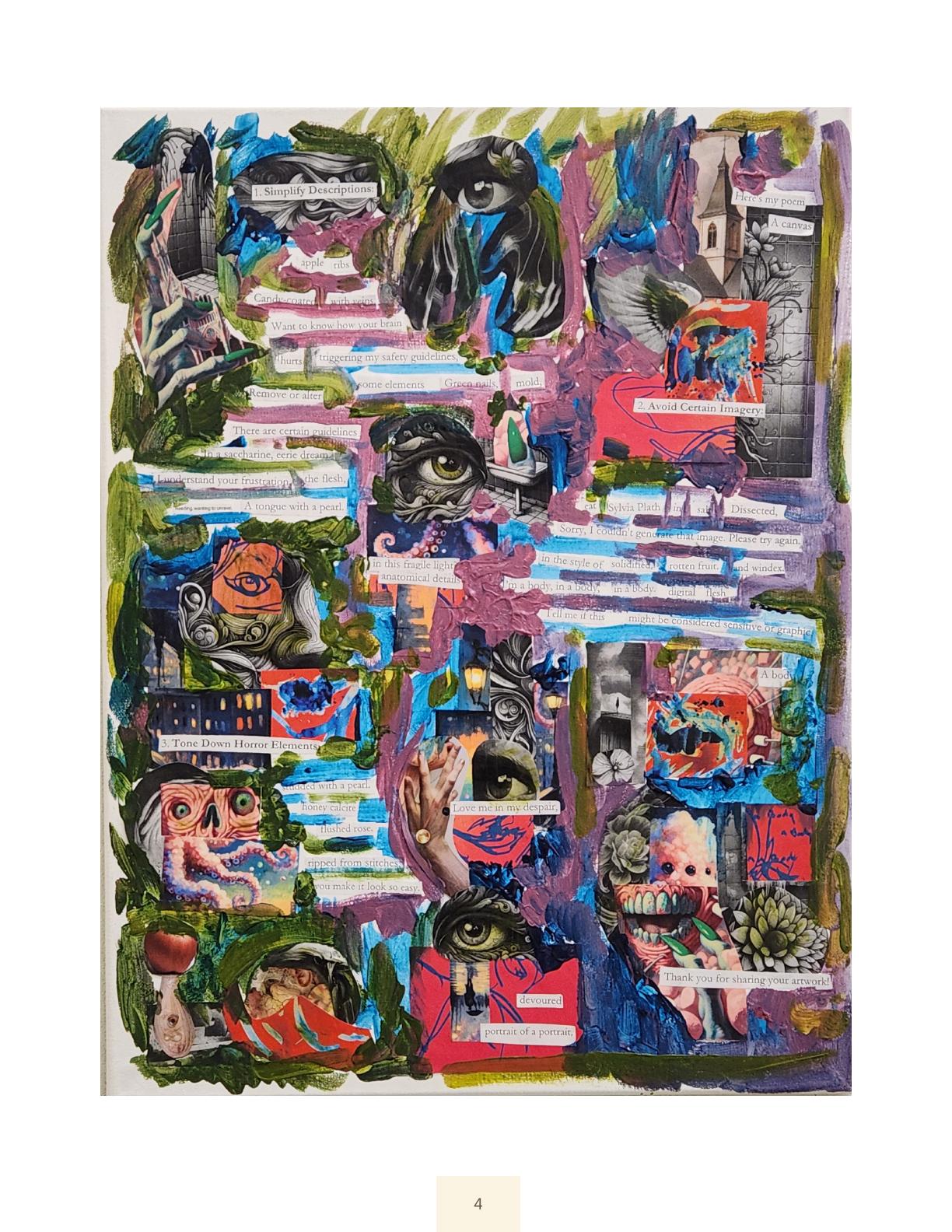
1
ISSN: XXXX-XXXX SPECIAL ISSUE 2025
This work is licensed under an Aribution-NonCommercial-NoDerivatives 4.0 International license.
EGESTA
Dre Levant
Bachelor of Arts, Creative Writing, Minor in Visual Art, 2025
This special issue of Future Earth Journal:
Explorations in Art and Generative AI showcases
the work of visual art students from the Fall 2024
Selected Topics visual art course Explorations in Art
and AI. Each featured artist engaged with genera-
tive artificial intelligence (Gen AI) to create original
artworks that respond to and reflect on current
conversations in art and technology. Through their
unique practices, these students explored Gen AI as
a tool, a collaborator, and/or a conceptual influence.
The artworks featured here—and in the exhibi-
tion held at the TRU Art Gallery from March 17–29,
2025—highlight the cultural, ethical, environmental,
and creative dimensions of using Gen AI in artistic
production.
Dre Levant is one of the participating artists
whose work exemplifies this exploration.
AI Source: Microso Copilot
ARTIST STATEMENT
The following artist statement’s first dra was
generated with Microso Copilot, however; the
final product was reworked and changed numerous
times, to the point it is indefinitely my own work.
My art piece, “Egesta,” is an amalgamation
of text conversations with Microso Copilot and
cut-up AI-generated images alongside my own art.
With the growing popularity of AI integration into
art practice, concerns arise about the authorship
of certain art; so, for this project, it was of utmost
Figure 1. Egesta (2024) by Dre Levant. Mixed media, 24”
x 18” (Image credit: Nicole Favron)

2
important to me to stay aware of the ambiguity of
ownership and do everything within my power to
create a project that was driven by my creative con-
trol. I decided to employ two of my favourite modes
of art-making: collage and cut-up poetry. Through
these, I could use text conversations and image
prompting with Microso Copilot to create some-
thing new and under my creative direction. To create
the text and images, I messaged Copilot, asking it
to write poems and create images inspired by the
poems – my original work – I fed it, as well as create
poems and images inspired by my original artwork.
These dialogues resulted in pages of poetic text
exchanged between us, as well as a small collec-
tion of generated images alongside my own images.
I then amalgamated select images and poems into a
doc and printed them; once printed, I cut and pasted
both text and image into new forms on a canvas.
"I wanted to include this interaction
[Figure 2] that actually le me a lile
speechless. I wrote the poem in the top
le corner, then asked Copilot to generate
an image inspired by my poem. Some of
the images it had generated in response
to my work had been lacklustre, but this
– this image really struck me; it is beyond
what I would hv e thought Copilot could
make. It's an image that – to me – is alto-
gether new and exciting."
I believe, through collage and cut-up poetry,
new meaning can be infinitely gleaned out of mate-
rial. What makes collage and cut-up poetry valid
forms of art is when they are changed from their
original form into something altogether new. None
of the images or text included in my art piece are full
images or full sentences generated by Copilot – they
are now all intertwined, with my own words and art,
alchemized and refracted from their original config-
uration. Through being cut-up and re-arranged, the
text and images take on new meaning: the inclusion
of the phrases, “Avoid Certain Imagery” and “Tone
Down Horror Elements,” become ironic and satirical
when pasted next to graphic text (“eat Sylvia Plath in
salt Dissected”) and disturbing images (a green-eyed
worm thing with cloud tentacles). My poetry and –
visual art – oen has a horror element to it, with
just a flair of whimsy and humour, I think “Egesta,”
expresses that fully (i.e. boom right corner reads,
“Thank you for sharing your artwork! ,” alongside a
four-eyed, toothy creature paired with flowers).
"What stops me from fully thinking of
the image as art is the fact that I still
know it was generated by an algorithm
that trained on stolen work, and the
artistic choices aren’t coming from a
creative, but rather an algorithm."
Working on this project challenged me to
research and contemplate the ways in which AI is
infiltrating not just art, but the world at large. I defi-
nitely think there is a place for AI (it genuinely can
make parts of life easier) and even a place for AI in
practical applications in art (having AI help write an
artist statement, for example) – but when it comes
to sheer creativity, I believe this comes from the
artist, and cannot be replicated. I hope my piece
challenges those who see it, makes them reflect
Figure 2. Dre Levant’s original poem “Chaos Colour Cacophony”
and Microso CoPilot’s image in response
Exhibition Poster (2024) (Photo
credit: Twyla Exner)

3
on the use of AI in their own lives, whether that’s
positive or negative. I want it to make people angry.
I want it to startle and stop you.
[Figure 3] Here I gave Copilot one of my orig-
inal artiworks an dasked it to write a poem
inspired by Sylvia Plath. Both here and in
other responses, I found Copiolot oen wrote
poems in a somewhat generic and cliché way.
Since I had already planned todo cut-up poet-
ry, I wasn’t’ that concerned, as I knew I would
be rearranging and picking what words and
phrases to keep.
Tribute
The artist wishes to note that in an eort to
oset CO2 emissions generated by this project
from the use of Microso Copilot, they have made
a donation equivalent to the planting of five tress (a
small grove) in British Columbia via the organization
A Living Tribute (hps://shop.alivingtribute.ca/).
Process
Dre worked with [Microso] Co-pilot as a col-
laborator. They fed it their original poems and asked
it to generate images based on the poems (Figure 2).
They also fed it their original artworks and asked it to
create poems in the style of Sylvia Plath, based on
their art (Figure 3). While they found some aspects
of these outcomes interesting, they didn’t want to
present either the generated images or the gen-
erated poems as their work. So, they printed the
poems and images generated with AI, cut them up,
and collaged them into a mixed media work.
Figure 3. Dre Levant’s original artwork (untitled) and Co-Pilots
poem in the style of Sylvia Plath in response

4
Egesta (2024) by Dre Levant. Mixed media, 24" x 18" (Image credit: Nicole Favron)
